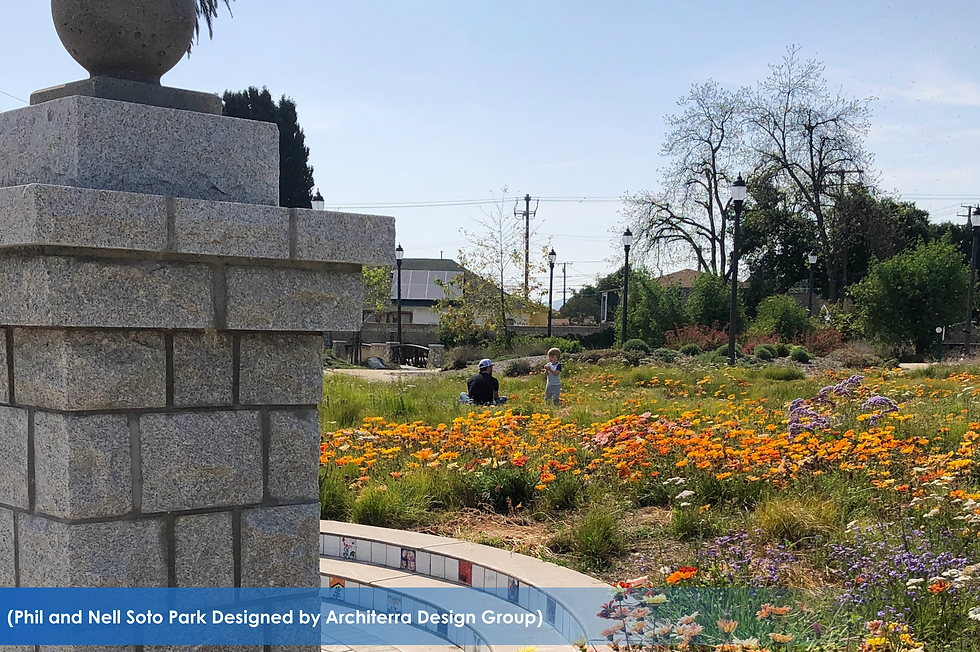Nature's Prescription: A Remedy for Stress. How is Nature Good for Mental Health?
- Architerra Design Group

- Nov 14, 2024
- 4 min read

The world seems to be providing more and more challenges to your mental health. From concerns over affording rent and groceries, to deep political and social divides, to concerns over increasing violence, it can seem like you’re being overwhelmed by anxiety and stress. Focusing on everyday life becomes a challenge and larger issues seem to be insurmountable. People need a way to disconnect from the constant stress to be able to refocus and avoid burnout.

Vacations are the common suggestion for helping to relieve anxiety, but many of us can’t afford a vacation either in travel expenses or in lost time from work. This is where nature and landscape come in. Taking a walk in your local nature park or national park can provide many of the benefits of a vacation without breaking the bank or requiring time taken off work.
So, how is nature good for mental health? Many studies, both medical and psychological, have been done regarding the relaxing effects natural settings have on both the body and the mind. Walks in natural environments have been shown to reduce heart rate and feelings of sadness (Hartig, Evans, Jamner, Davis, & Garling, 2003) helping you to relax. Walks in nature have also been shown to directly reduce anxiety while improving cognitive functioning (Bratman, Daily, Levy, & Gross, 2015). Exposure to floral scents can lower depression (Jo, et al., 2013). Being in green spaces also lowers levels of Perceived Stress (Hazer, Formica, Dieterlen, & Morley, 2018). It is well-established that natural environments offer effective stress relief, and individuals with access to such spaces frequently utilize them for this purpose (Townsend & Weerasuriya, 2010).

What if you don’t have a nature park or natural area nearby to take a walk in? Or you don’t have the time for a nice walk in the park? While full immersion in nature has the greatest benefits, your yard can also become a relaxation retreat.
Enclosed landscape areas that still provide a view provide the sense of safety by allowing you to shut out problems and worries without feeling trapped (Sidenius, The Therapy Garden Nacadia, 2017). A small area that can be surrounded by plants with a tree providing shade but still allowing a view of the sky can accomplish this safe escape. The presence of both still water and flowing water, if possible, enhances the effect of the area (Soderback, Soderstrom, & Schlander, 2004).

Individuals desiring a social yard space may benefit from savanna-like settings, which have been shown to decrease fear and anger (Frumkin, 2001). However, such spaces should also incorporate tranquil areas for social interaction (Wagenfeld, Roy-Ficher, & Mitchell, 2013).
Most important is a variety of options. These options include sun or shade, social area or private retreats, sheltered passive areas or workspaces and a variety of plants (Anderson, 2011). The combination of scents, weather and wildlife in the landscape areas help foster a greater sense of self-awareness (Poulsen, Stisdotter, Djernis, & Sidenius, 2016).
Now that we know what kind of space works best, let's discuss how to plant it.

A study in Japan showed the most positive reaction to all green foliage (Elsadek & Fujii, 2015). Blue and white have also been shown to promote relaxation especially when combined with yellow accent color for interest & surprise (Hitter, Cantor, & Buta, 2017). A green dominated environment with blue and white accents would have a more positive effect on stress and relaxation than an environment that incorporates large amounts of red blooms.
While creating your own private retreat will help reduce your stress and anxiety, landscape can also be used throughout your neighborhood to help reduce violence and increase cognitive development in children. Interacting with nature has led to a decrease in attention deficit symptoms in children (Taylor, Kuo, & Sullivan, 2001). Adding green spaces throughout the neighborhood and especially in schoolyards allows children to interact with nature on a daily basis. The addition of street trees in a neighborhood have been linked to a reduction in violent crime (Burley, 2018). Studies have also shown that access to nature decreases aggression (Kuo, Sullican, & Wiley, 2001).

In an era marked by increasing stress and anxiety, the importance of natural environments cannot be overstated. By providing solace, reducing stress, and enhancing cognitive function, nature offers a powerful antidote to the challenges of modern life.
Whether it's a serene walk in a local park, a contemplative moment in a private garden, or the vibrant greenery of a neighborhood, the benefits of connecting with nature are far-reaching. By incorporating natural elements into our surroundings, we can create spaces that promote well-being, reduce stress, and inspire creativity.
As we move forward, it is crucial to prioritize the preservation and expansion of green spaces. By doing so, we can foster healthier, happier, and more resilient communities.
References: Walton et al. (2017), U.S. Department of Veterans Affairs (2018), The Management of Post-Traumatic Stress Working Group (2004), Anderson (2011), Sawada & Oyabu (2010), Kuo, Sullican, & Wiley (2001), Hartig et al. (2003), Bratman et al. (2015), Jo et al. (2013), Park et al. (2007), Detweiler et al. (2015), Sidenius (2017), Sidenius et al. (2017), Poulsen et al. (2016), Tyrväinen et al. (2014), Hazer et al. (2018), Wagenfeld et al. (2013), Frumkin (2001), Elsadek & Fujii (2015), Hitter et al. (2017), Soderback et al. (2004), Stowell et al. (2018), Stigsdotter (2015).
Credits: Author: Kay Kite - (Editor: Clara Boline)




コメント